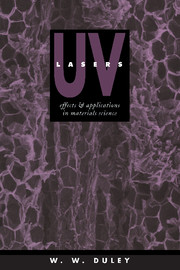Book contents
- Frontmatter
- Contents
- Preface
- Acknowledgments
- 1 Short wavelength lasers
- 2 Optical properties of materials at UV wavelengths
- 3 Photochemical and photothermal effects
- 4 Interaction of UV laser radiation with metals
- 5 Interaction of UV radiation with organic polymers
- 6 Interactions and material removal in inorganic insulators
- 7 UV laser preparation and etching of superconductors
- 8 Interactions and effects in semiconductors
- 9 Laser deposition
- Index
6 - Interactions and material removal in inorganic insulators
Published online by Cambridge University Press: 16 November 2009
- Frontmatter
- Contents
- Preface
- Acknowledgments
- 1 Short wavelength lasers
- 2 Optical properties of materials at UV wavelengths
- 3 Photochemical and photothermal effects
- 4 Interaction of UV laser radiation with metals
- 5 Interaction of UV radiation with organic polymers
- 6 Interactions and material removal in inorganic insulators
- 7 UV laser preparation and etching of superconductors
- 8 Interactions and effects in semiconductors
- 9 Laser deposition
- Index
Summary
INTRODUCTION
The response of inorganic insulating materials to intense UV radiative fluxes is complex and involves both photophysical and photochemical interactions. The first effect, noticeable at low exposure, involves the production of defect centers or radiative interactions with existing centers or impurities. Such changes often result in an increase in optical absorption at the laser wavelength as well as at other wavelengths. This can have a profound effect on the quality of transmissive optical components such as windows and lenses. With optical fibers, defect formation limits the fluence that can be transmitted.
Higher exposure to radiative fluxes results in changes in composition and density as the sputtering threshold is approached. Defects have been found to play a significant rôle in the initiation of ablation under irradiation with photons of energies less than that of the optical bandgap. The generation of electron–hole pairs via two-photon absorption is also an important process at high laser intensities and would appear to be the initiator of ablative decomposition of transparent insulators.
This chapter begins with a review of the formation and properties of dominant defects in several wide bandgap insulators. The relation between these defects and the coupling of UV laser radiation leading to ablation is then discussed. The chapter concludes with a summary of dry and laser-assisted etching processes and rates in a variety of insulating solids.
- Type
- Chapter
- Information
- UV LasersEffects and Applications in Materials Science, pp. 232 - 275Publisher: Cambridge University PressPrint publication year: 1996



